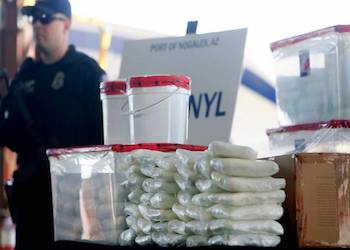Fentanyl seizures along the US-Mexico border have hit record highs, suggesting that, despite a supposed ban on production of the deadly synthetic opioid in parts of Mexico, a multitude of criminal groups are keeping production apace.
United States Customs and Border Protection (CBP) agents seized 12,119 kilograms (26,718 pounds) of illicit fentanyl along the country’s southwest border with Mexico in the 2023 fiscal year, which runs from October to September. This marked a nearly 90% increase from the 6,397 kilograms (14,104 pounds) officials seized in the previous fiscal year.

The surge in seizures comes as the Chapitos faction of the Sinaloa Cartel reportedly ordered a halt on the production and trafficking of fentanyl in Sinaloa. The move came after the US government ramped up efforts to prosecute alleged fentanyl traffickers, chief among them Ovidio Guzmán López.
Guzmán López is accused of running the Chapitos alongside Iván Archivaldo Guzmán Salazar, Jesús Alfredo Guzmán Salazar, and Joaquín Guzmán López, all children of former Sinaloa Cartel leader, Joaquín Guzmán Loera, alias “El Chapo.” Mexican authorities arrested Ovidio for the second time in January 2023; he was subsequently indicted by US prosecutors in April and extradited to Chicago in September.
SEE ALSO: How Fentanyl Is Synthesized in Mexico
Guzmán is the poster boy for fentanyl. More than anyone else, the US government holds him responsible for an unchecked rise in overdose deaths attributed to the synthetic opioid. In 2022, data from the Centers for Disease Control and Prevention (CDC) found that opioids, primarily illicit fentanyl, contributed to about three-quarters of around 110,000 overdose deaths recorded across the country.
Illicit fentanyl manufactured in Mexico is often pressed into counterfeit M30 Oxycodone pills, which are known as “blues” for their color. A September 2023 report from the CDC found that illicit fentanyl was the sole drug found in 41.4% of US drug overdose deaths involving counterfeit pill use between mid-2019 and late-2021.
The potential lethality of these pills may have expanded even further. Last month, the US Drug Enforcement Administration (DEA) stated that laboratory testing of counterfeit pills showed seven of every 10 seized by the agency contained a deadly dose of fentanyl, or about two milligrams. Two years earlier, the DEA said just four of every 10 fentanyl-laced pills contained a potentially lethal dose.
InSight Crime Analysis
The record fentanyl seizures, as well as the increased lethality of the counterfeit pills, underscore just how stratified this market is, which any organized crime group, even the vaunted Sinaloa Cartel, will have a hard time curtailing.
US anti-drug officials have pointed to the Sinaloa Cartel and its factions as being among Mexico’s primary fentanyl traffickers. That is why, when the criminal organization placed a ban on fentanyl production and trafficking earlier this year, some impact on prices and availability in the United States was to be expected.
What’s more, it was not just the Chapitos who were pushing the ban. Several fentanyl suppliers interviewed by InSight Crime around the time of Ovidio’s extradition said that networks associated with the Chapitos, as well as Ismael Zambada, alias “El Mayo,” another central figure within the group, were all enforcing the ban. And further north, other Sinaloa Cartel cells in Sonora and Baja California Sur announced their intention to follow the order. In various municipalities across Baja California, the Tijuana Cartel even claimed to be joining these efforts.
However, it’s not yet clear how the ban is impacting cross-border fentanyl flows, if at all. It’s also not clear if the ban is in place outside Sinaloa. In the five months since the Chapitos ordered the ban, Mexican security forces have continued seizing synthetic drug labs in Culiacán. At the same time, as noted, US authorities continue seizing record amounts of fentanyl along the southwest border and across the country.
Seizures, of course, are not a perfect metric.
“The issue is that seizures do not reflect supply, they reflect enforcement,” said Cecilia Farfán-Méndez, head of security research programs at the University of California, San Diego’s Center for US-Mexican Studies.
Still, they are one of the few empirical indicators illicit drug watchers can use to measure supply and demand. If taken at face value, these shipments appear to signal continued production from multiple groups.
SEE ALSO: Are Fentanyl Trafficking Routes Shifting on the US-Mexico Border?
Another indicator of this stratification is purity. The purity of illicit fentanyl seized by authorities varies considerably, according to DEA laboratory testing results obtained by InSight Crime, indicating there are many producers from multiple groups and no standardized production method.
A third indicator is price. Lower prices would indicate oversupply; higher prices might indicate the Sinaloa Cartel’s ban on production is having an impact. But prices vary widely across the United States, making it difficult to come to any clear determination concerning the ban.
Data provided to InSight Crime by various US law enforcement agencies indicate counterfeit pill prices are between $0.35 and $20 a pill. In McAllen, Texas, for instance, where fentanyl has only recently arrived, a single pill is being sold for $10 to $20, according to anti-drug officials. Counterfeit pills are being sold in the same price range in Chicago and between $5 and $10 in Los Angeles, according to state and local police.
But other consumer markets appear to have an oversupply of illicit fentanyl, which could be driving prices down. Along the border in Nogales, Arizona, for example, city police told InSight Crime that a single counterfeit fentanyl pill is being sold for between just $0.35-$0.60. Similar price points were also seen in northwest cities like Portland and Seattle, where fentanyl has been readily available for years.
In production hotspots like Sinaloa, arguably the epicenter for fentanyl synthesis in Mexico, wholesale prices have also dropped drastically. While a kilogram of counterfeit pills containing fentanyl sold for $9,000 in early 2022, the price fell to just about $3,000 at the start of 2023, according to synthetic drug producers who spoke with InSight Crime in Sinaloa.

